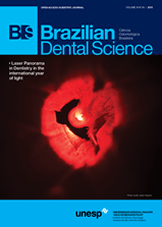Mechanical properties of the bond interface associated with nd:yag laser
DOI:
https://doi.org/10.14295/bds.2015.v18i4.1172Abstract
ABSTRACT
Objective:This study evaluated the hardness and modulus of elasticityof the dentin bond interface using total-etch (Single Bond /SB) and self-etch (Clearfil SE Bond/CSEB) adhesives associated with Nd:YAG Laser irradiation through the unpolymerized adhesives.Material and Methods: The occlusal surfaces of 12 human third molars were ground until superficial dentin was exposed. A standardized circular cavity was performed on the occlusal surface. Specimens were sectioned in the mesio-distal direction, and the 24 hemi-crowns were divided into four groups: Group SB/Control - SB + polymerization; Group SB/Laser - SB + Nd:YAG laser (174.16J/cm2/60s/non-contact) + polymerization; Group CSEB/Control – CSEB + polymerization; Group CSEB/Laser - CSEB + Nd:YAG laser (174.16J/cm2/cm2/60s/non-contact) + polymerization. Composite were placed in the cavities and polymerized. The specimens were immersed in distilled water and stored in an oven at 37ºC for 24h and then submitted to nanoindentation in a Nano Indenter® XP appliance. Results: The results were submitted to ANOVA, Tukey’s test and Student's-t test (p < 0.05). Conclusão: It was concluded that the application of the Nd:YAG laser in both adhesive systems did not changed the hybrid layer hardness; however, it increases the modulus of elasticity in the hybrid layer for both adhesives tested and it maybe preserves the integrity of the adhesive interface and its durability. Clinical relevance: The application of Nd:YAG laser prior to photopolymerization of adhesive systems can increase the modulus of elasticity in the hybrid layer and may contribute to stress distribution in the adhesive interface during the polymerization preserving the integrity of the adhesive interface and its durability.
Downloads
Downloads
Published
How to Cite
Issue
Section
License
Brazilian Dental Science uses the Creative Commons (CC-BY 4.0) license, thus preserving the integrity of articles in an open access environment. The journal allows the author to retain publishing rights without restrictions.
=================




























